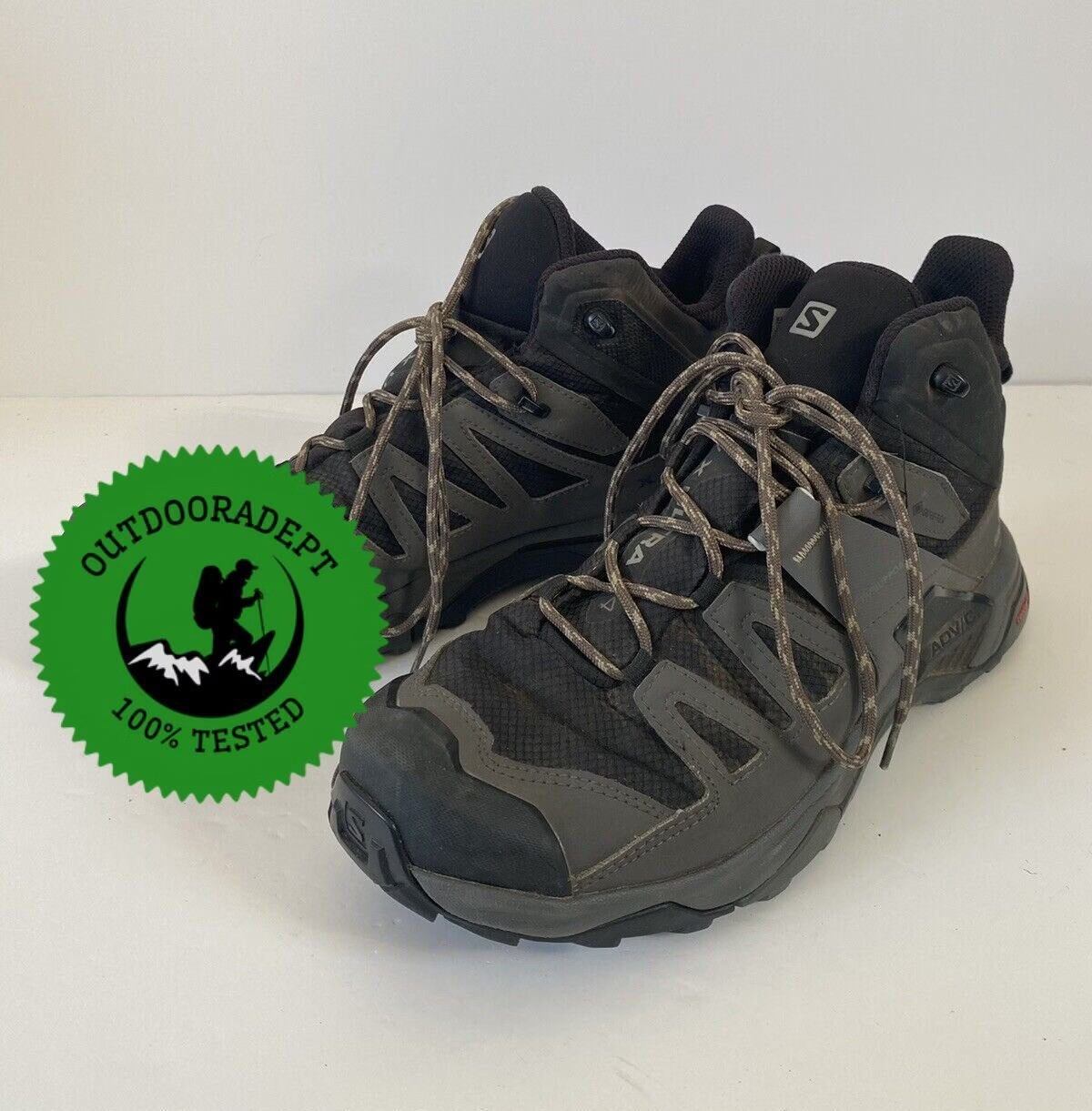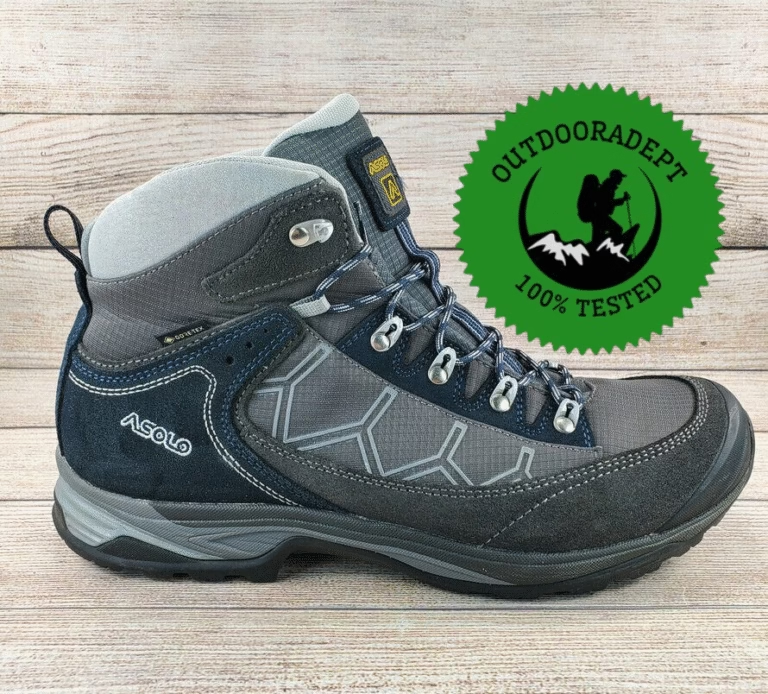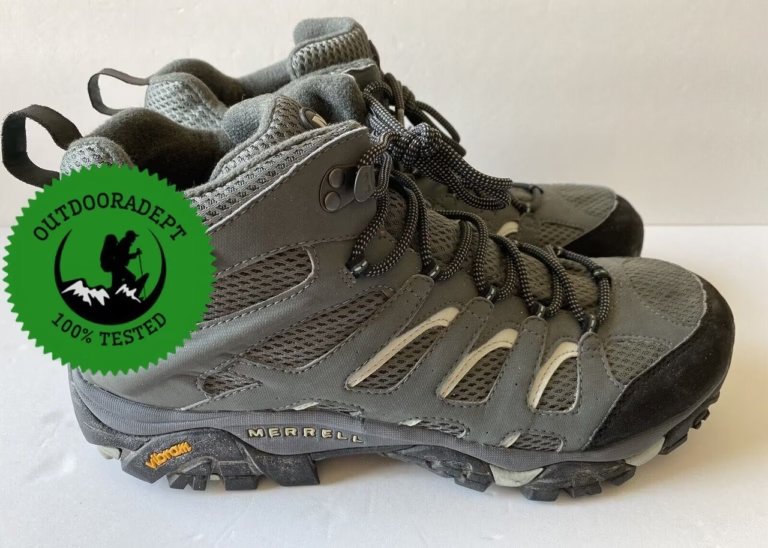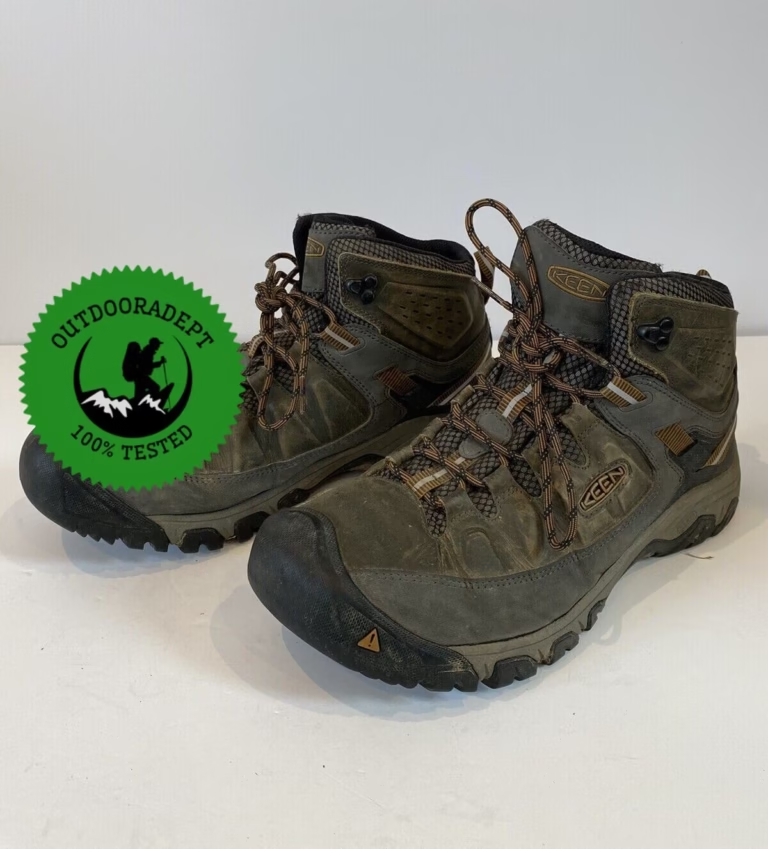While hiking the rocky trails of the Grand Canyon, I found these boots not only performed well but also provided amazing support and stability—all without feeling heavy.
There were a few areas in the canyons that stretched the boots’ limits, but for the most part, they felt really good and comfortable on the trail.
One of the reasons I appreciate this footwear is that its design strikes a balance between a hiking boot and a hiking shoe.
Our Verdict
Salomon X Ultra 4 Mid GTX
The Salomon X Ultra 4 Mid GTX hiking boot is a mid-height boot made to traverse technical terrain, provide better ankle support, and serve as a lighter alternative to the previous model in the X Ultra product line.

The protective cushioning underfoot could be improved, but over long distances, these boots still felt comfortable.
They offer a blend of both worlds; even though they don’t provide the full protection of a traditional boot, the X Ultra 4 makes up for this with its lighter weight and enhanced mobility.
That said, let’s jump into the Salomon X Ultra 4 Mid GTX review and see how well this hiking boot did during its testing phase.
To conduct a comprehensive review of the Salomon X Ultra 4 Mid GTX, we tested this model across various terrains, including flat, rocky, muddy, and gravel surfaces. We rigorously evaluated its waterproof capabilities in rainy conditions and overall performance in hot weather. Our team, along with independent experts, assessed the shoe over multiple days to determine its break-in period and comfort level. The Salomon X Ultra 4 Mid GTX was rated on key criteria such as fit, cushioning, tread, breathability, and more. After compiling average scores from these tests, we also considered external user feedback and the manufacturer’s warranty to provide a well-rounded review of this hiking shoe
This is the mid-cut version. For the low-cut version, check our in-depth Salomon X Ultra 4 GTX Review
Highlights
| Feature | Salomon X Ultra 4 Mid GTX |
|---|---|
| Weight | ~1 lb 11.5 oz (approx. 765 g) |
| Water Resistance | Gore-Tex membrane; effective in light to moderate conditions |
| Traction | Contagrip MA outsole with multi-directional lugs; excellent grip |
| Comfort | Molded OrthoLite sockliner; lightweight design; minimal break-in required |
| Adjustability | Traditional lacing system; secure fit |
| Breathability | Moderate; Gore-Tex lining reduces airflow |
| Durability | PU-coated leather and textile upper; abrasion-resistant; reinforced toe cap |
| Arch Support | Moderate; may require custom insoles for higher arches |
| Toe Protection | Reinforced toe cap; robust protection |
PROS
CONS
Things We Tested When We Reviewed Salomon X Ultra 4 Mid GTX
1. Traction
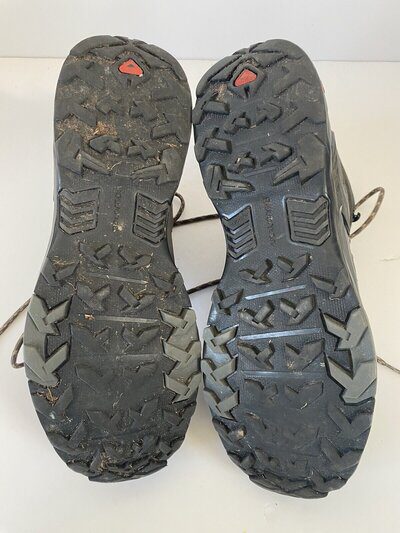
The Salomon X Ultra Mid GTX is designed with a Contagrip MA outsole.
This is an all-terrain rubber outsole made to handle wet, dry, and loose surfaces.
With a decent number of multi-directional lugs and a deep depth, this hiking boot gave me a firm grip on surfaces that any other hiking shoe or boot would’ve failed at.
As with most Contagrip soles, I appreciate that I can wear them in any trail conditions without a loss of performance, or feeling like I need to bring an additional pair of footwear.
2. Durability
They are made with PU-coated leather and textile upper material, making them both flexible and durable. Strategically, the leather lines the parts of the hiking boot where wear and tear usually occur for most hikers, significantly increasing its lifespan.
However, what I really enjoyed was the fact that the toe box provided a lot of protection. The canyons are filled with rocks and jagged edges, which I scraped against constantly, but these boots survived the whole trip.
3. Comfort

The Salomon X Ultra 4 Mid GTX uppers are flexible enough to prevent stiffness and constriction when putting on the hiking boot.
The X Ultra 4 Mid easily conforms to the shape of the foot, has a nice padded tongue, and heel padding, and has a soft ankle collar.
Sadly, because it’s made with lighter materials, it lacks the necessary underfoot protection to manage heavier backpacking loads.
These hiking boots work well for most day hikes and backpacking trips but expect to feel more of the trail under your feet along the way.
4. Breathability
Just like other hiking boots with a Gore-Tex layer, these Ultra Mid boots are waterproof but can also make your feet warm because they don’t breathe very well. They’re lighter and thinner, yet this doesn’t change how they handle wet conditions and airflow.
They are great for cooler climates since they keep some heat in, which I found useful during the cold in Arizona.
5. Weight
Weighing 1 lb. 14.4 oz., the Salomon X Ultra 4 Mid GTX trims some weight compared to previous versions [1].
As one of the lightest hiking boots in the X Ultra product line, these boots have enough padding to cushion your foot on moderate trails but are still thin enough to have a noticeable decrease in protection on rocky terrain.
However, because of its weight, the X Ultra 4 Mid also accommodates people who want to feel like they’re wearing a lightweight hiking shoe, but without the build of a traditional hiking boot.
6. Waterproofing

They use a Gore-Tex waterproof membrane and during our tests, it seemed to be very resistant to water. These boots have kept my feet dry for many hikes and the uppers don’t absorb any water.
The mid height collar on the X Ultra 4 has a pretty good flood barrier, so you can move through stream crossings and rainy conditions without any real issues. However, always be aware of your depth before your foot is submerged in water to prevent overflowing.
7. Support
The Salomon X Ultra 4 Mid GTX has an ADV-C Chassis System and Active Support bands. Despite resembling a lightweight hiking shoe, the X Ultra 4 is extremely stable. As mentioned before, the collar is very soft and has great ankle support.
The insoles also have excellent arch support, which is great if you suffer from flat arches like me.
Finally, the lacing system ties everything together with a classic closure style, instead of the single-pull system that some others dislike. Overall, excluding the thin midsole, the X Ultra 4s support features are ideal for most situations.
8. Fit & Sizing

The Salomon X Ultra 4 Mid GTX has a snug fit.
Combined with the locked-in heel and traditional lacing system, I haven’t experienced any areas of slippage anywhere in the boot.
Originally, I was worried that the thin cushioning would make things a little loose, but this hasn’t been a problem.
Even the forefoot of the boot is properly spaced, allowing room for the toes to breathe.
These hiking shoes are offered in a wide version to accommodate wide feet, but even a normal fit shapes well around a narrow foot, so anyone should be able to find a boot in their size.
How Has It Evolved Over Time?

The Salomon X Ultra 3 Mid GTX was a well-rounded hiking boot, but compared to the Salomon X Ultra 4 Mid GTX, its flaws are more obvious. The X Ultra 4 Mid integrates an improved ADV-C chassis, giving it added stability and control on rough terrain.
The X Ultra 4 Mid has also been trimmed down to 1 lb. 14.4 oz., compared to its predecessor’s weight of 1 lb. 15.6 oz. The decrease in weight is accompanied by more toe space and a larger volume in the forefoot.
The last major improvement to these hiking shoes is its Contagrip MA outsole. While the previous boot also used a rubber outsole, the Contagrip MA is meant to be more adhesive in all environments, including dry, wet, and loose rock.
Overall, the X Ultra 4 has managed to pack in a lot more versatility than most heavier hiking boots.
How Does it Compare with Other Products?
1. Salomon Quest 4 GTX

The Salomon Quest 4 GTX has a much heavier build compared to the Salomon X Ultra 4 Mid. At 2 lbs. 14.4 oz., the Quest 4 is much bulkier, making it more suited for hauling heavier loads on backpacking trips.
The level of protection is also superior, providing better underfoot comfort than the X Ultra 4. However, the X Ultra 4’s most impressive feature is its lightweight design.
Whereas the Quest 4 is made to handle off-trail hiking and more advanced paths, the X Ultra 4 excels as a lightweight hiking boot for moderate paths. Learn more about this product by checking the full review of Salomon Quest 4 GTX hiking boots.
2. Vasque Breeze LT Mid GTX

The Vasque Breeze LT-Mid GTX hiking boot is made with a Vasque-exclusive Vibram Megagrip outsole.
This stiffer boot outsole is responsible for a 25% decrease in the boot’s overall weight, and manages to retain the same reliability and traction usually seen with a Vibram outsole.
Weighing 1 lb. 11 oz., the Vasque Breeze LT is a little lighter than the X Ultra 4, but it’s built with a very durable, abrasion-resistant microfiber mesh.
Overall, the Vasque Breeze has even better weight reduction than the X Ultra 4, but similar on-trail performance.
So, the choices between these two boots ultimately come down to personal preference, but keep in mind that the X Ultra 4 is a few dollars cheaper than the Vasque Breeze LT.
3. Merrell Moab 3 Mid Waterproof
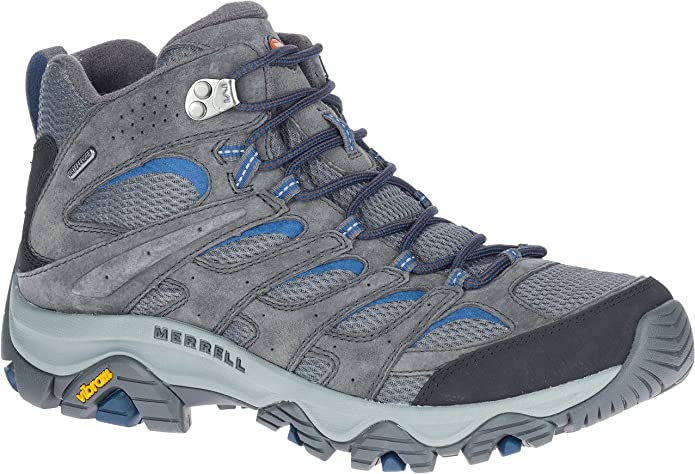
The Merrell Moab 3 Mid Waterproof is a solid boot that has decent support, protection, and good performance on the trail.
Despite being made with recycled materials and having a mesh lining, which is prone to premature wear and tear, the Moab 3 manages to be durable, while also balancing support, comfort, and protection.
While it doesn’t necessarily excel in any one area, the Moab 3 is meant to be versatile. However, the X Ultra 4 has more of a nimble and snappy feel.
Additionally, it combines the features of a hiking shoe, making it ideal for hiking conditions that the Moab 3 may not be as reliable to use. In the end, your skill level and hiking routines will play a role in which of these boots is the better choice.
Check our complete review of Merrell Moab 3 Mid Waterproof to learn more about this product.
Where Does the Salomon X Ultra 4 Mid GTX Perform Better?
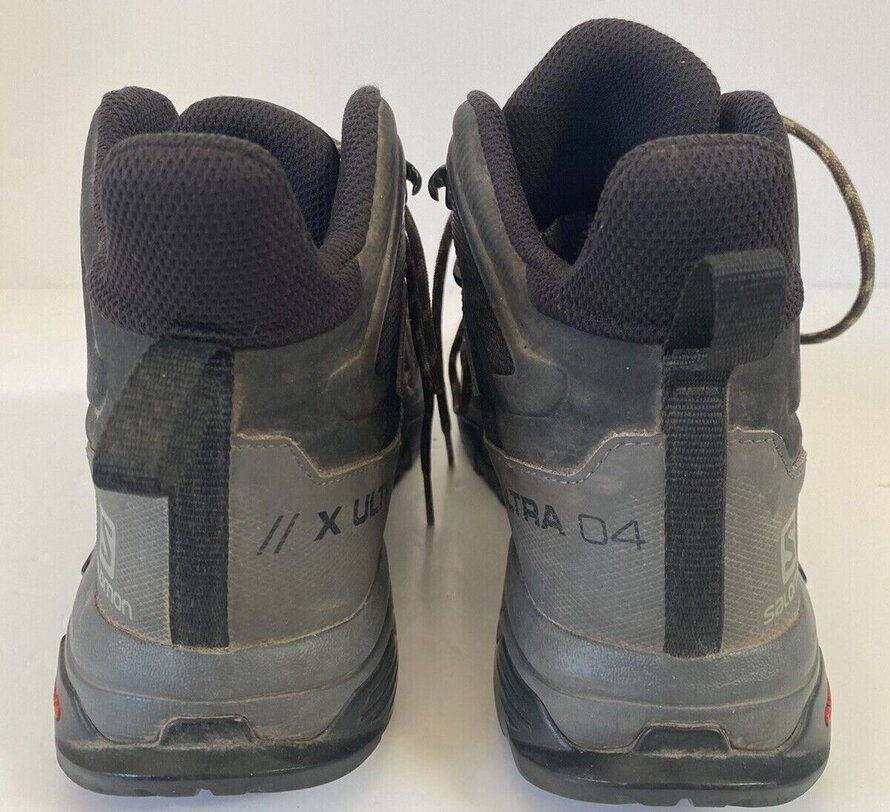
After trying out this hiking footwear, we found that it performs better on well-maintained trails while hauling light pack loads.
If you’re stepping over small sticks, branches, or walking over uneven surfaces, the sole has enough protection and durability to manage without breaking down.
The PU-coated leather is also resistant to most trail hazards, so it can take a pretty rough beating. The weatherproof material that lines the X Ultra 4 Mid is adaptive to moderate trail conditions, allowing you to hike in nearly any climate.
Additionally, the ActiveSupport bands and cushy SensiFit technologies, make it easier to hike for longer distances without stressing your heels, arches, or toes.
We’ve also tested the low version of this shoe so feel free to check our Salomon X Ultra 4 GTX review.
Where Does the Salomon X Ultra 4 Mid GTX Fall Short in Performance?

As shown by our tests, this hiking footwear falls short on rough terrain, specifically, areas where the trail has jagged surfaces or a lot of trail debris that could stress the underfoot.
While they can’t be used as running shoes, the X Ultra 4 Mid trims significant weight, which unfortunately reduces the level of support the hiking boot can provide in specific situations.
The other downside is that, unlike other Salomon brand shoes, the X Ultra 4 only comes in a GTX version.
Since the GTX version of this footwear can run hot in warmer weather, using this for long hikes in the middle of the spring or summer could result in sweat buildup and consequently, slippage issues.
Custom Reviews
Although we largely depend on our testing procedures, we nonetheless want to offer some Salomon X Ultra 4 Mid customer reviews.




Where to Buy?
| WHERE TO BUY? | FOR MEN | FOR WOMEN |
|---|---|---|
| REI | N/A | N/A |
| Amazon | See Pricing» | See Pricing» |
| Backcountry | N/A | N/A |
| eBay | See Pricing» | See Pricing» |
FAQs
GTX in Salomon shoes means that the footwear is designed with a Gore-Tex waterproof breathable membrane. This seals off the inside of the boot from water while also allowing for some ventilation.
The Salomon X Ultra 4 Mid Gore-Tex women’s weighs 1 lb. 11.2 oz, which is 3 ounces less than the men’s version. Due to the differences between men and women, some footwear requires less padding than others, lowering the weight.
Salomon shoes are designed to be snug and form-fitting, but they should never be tight enough to make you feel uncomfortable. If you feel that your shoe is too constrictive or that your toes don’t have enough room, try sizing up.

